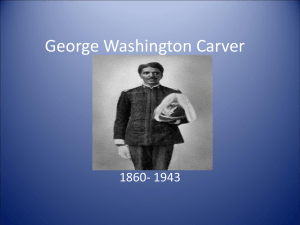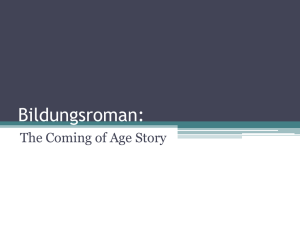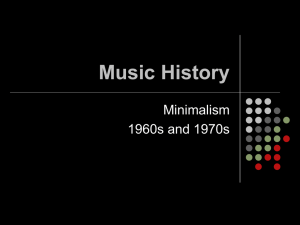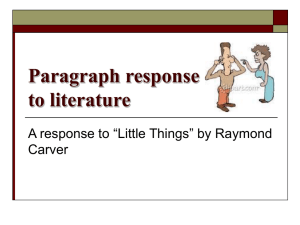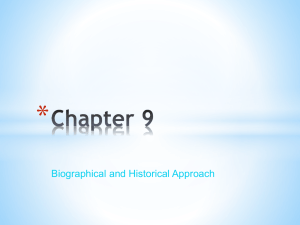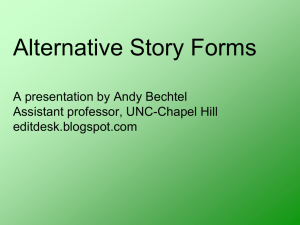110character12web
advertisement
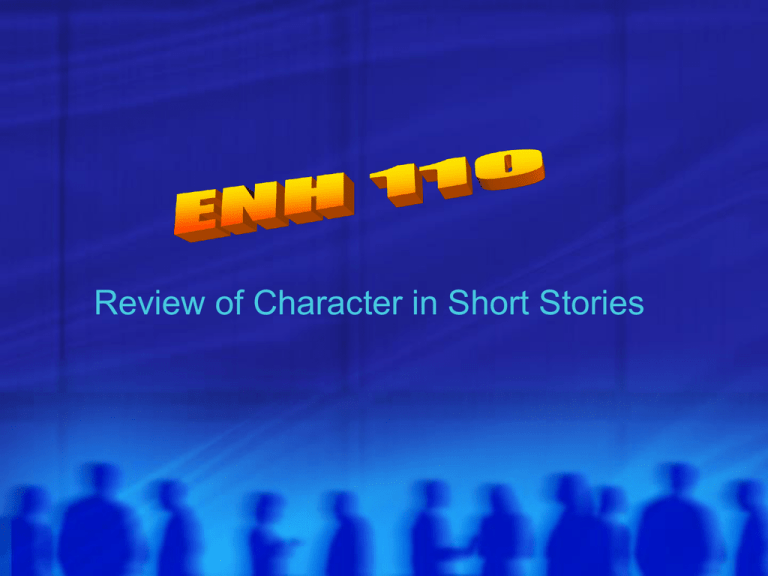
Review of Character in Short Stories A character is any representation of an individual being presented in a dramatic or narrative work through extended dramatic or verbal representation. The reader can interpret characters as endowed with moral and dispositional qualities expressed in what they say (dialogue) and what they do (action). CHARACTERIZATION: An author or poet's use of description, dialogue, dialect, and action to create in the reader an emotional or intellectual reaction to a character or to make the character more vivid and realistic. Careful readers note each character's attitude and thoughts, actions and reaction, as well as any language that reveals geographic, social, or cultural background. Methods of characterization Direct: Indirect: Expository Dramatic Explicit Implicit Most often used “Don’t’ simply say ‘the old lady screamed’; bring her on and let her scream.” Mark Twain Principles of Characterization Consistency He or she does not behave one way on one occasion and a different way on another unless there is a clear reason for the change. Motivation Plausibility The character’s words and actions must spring from motivations the reader can understand and believe. The author must create the illusion that the person is real so we can forget we are reading fiction at all. Types of Characters E. M. Forster: Aspects of the Novel, 1927 Round: multi-faceted, complex Flat one or two memorable traits can be summed up in a sentence Stock interchangeability Degree of Change Static: The character is the same at the end of the story as he or she is at the beginning. Developing or Dynamic: The character undergoes a permanent change in character, personality, or outlook. Often provides a clue to the story’s meaning, or theme A foil is a secondary character who contrasts with a major character and, in so doing, highlights various facets of the main character's personality. The author may use the foil to set up situations in which the protagonist can show his or her character traits. The term refers to the practice of putting polished foil underneath a gemstone to make it shine more brightly. An antihero is a protagonist conspicuously lacking in one or more of the usual traits of a traditional hero (bravery, skill, idealism, sense and purpose). “The antihero is an ordinary, unglorious citizen of the modern world, usually drawn (according to Sean O’Faolain) as someone ‘groping, puzzled, cross, mocking, frustrated, and isolated’ ” (Kennedy and Gioia 49). Epiphany Epiphany is Twelfth Night - 6 January - when Christ was visited by the Three Wise Men, and his divinity was revealed to the world. It derives from a Greek word, epiphainein, meaning 'to manifest', and in pre-Christian times it was used to record appearances of gods and goddesses. Traditionally the word has kept this specific religious association, but over the years it has been secularized to refer to other, non-divine forms of revelation. Joyce's secular epiphany The principal writer to extend the meaning of the word as a secular term was James Joyce, who was interested in sudden, dramatic and startling moments which seemed to have heightened significance and to be surrounded with a kind of magical aura. Alice Walker Born 1944 Biography Discussion prompts Critics who see Wangero as not respecting her American heritage and being a selfish individual find much in the story to defend Mama’s epiphanic moment in paragraph 76. If you agree with this point of view, what evidence do you think they would effect? If you see her (Wangero’s) character in a different light please discuss your reasons. Discussion prompts Do you see Maggie as a foil to Wangero’s character? Some see the following lines (par 13) as a foreshadowing of Mama’s reaction to Wangero’s predatory behavior. Do you? “I used to love to milk till I was hoofed in the side in ‘49. Cows are soothing and slow and don’t bother you, unless you try to milk them the wrong way.” Protagonist Mother and Maggie Antagonist Dee/ Wangero Honesty and Integrity Self posturing / artificiality Self-Sacrifice Rapacity utilitarianism aesthetisism Authentic relationship to a heritage of things made for “everyday use” Ethnic Pretentiousness The quilts symbolize the following: Inherited values Family attachments Independence Self-reliance The beauty of useful objects The virtue of craftmanship Possible themes for “Everyday Use” Ingrained habits may be given up if justice makes a greater demand. or A person whose honesty and tolerance have long made her susceptible to the strong will of another may reach a point where she will exert her own will for the sake of justice. Raymond Carver 1938-1988 Biography “Cathedral” discussion questions Is Carver’s narrator a static or dynamic character? Defend your position by specific reference to the story. Do you think he has the disposition of an “antihero”? Many critics think this story--based on its positive transformation of the narrator--produces a cogently uplifting effect. Agree? Disagree? Discussion prompt One thematic idea Carver’s story suggests is that through collaboration with others we may free ourselves from the slavery of self-absorption, that compassion is a prerequisite not just for happiness but survival. Do you agree? Disagree? Discussion prompt What symbolic value do you attach to the cathedral? Why do you think Carver used it as the title? Does the cathedral have a strong enough catalytic effect to make us “see” the the narrator’s insightful moment as numinous? Possible Themes for “Cathedral” Barriers tend to break down when people effectively communicate with one another. Even those not physically blind sometimes need to be taught “to see.” Stereotyping often renders sighted people “blind” to the common humanity we all share. Minimalism In the 1970's and 1980's, a mode of writing known as Minimalism became very popular. Minimalism presents what is often a bare, simplified snapshot of some event, insisting that the reader imagine the rest of the circumstances and guess about their impact. Minimalism can be characterized by ordinary subject matter, straightforward narratives, and slightness of story. Minimalism reflects a number of contemporary thoughts. First of all this style reflects the growing complexities of the world by refusing any attempts at explaining the presented reality to the reader. Minimalism also suggests that contemporary life has become too bland and standardized to support a strongly dramatic art; we shop in malls, eat fish sticks, and sleep under electric blankets. Minimalism also reflects the post-modern idea that the story does not exist without the reader. Since the story takes place in the reader’s mind, the reader needs to create the story as much as the writer does. Raymond Carver, although he never liked to be labeled as one, was considered by many critics to be a minimalist.


